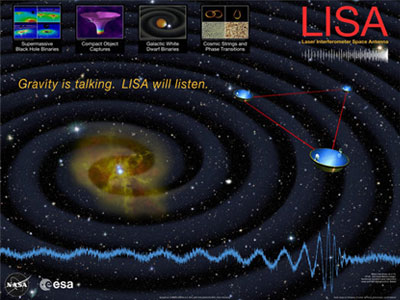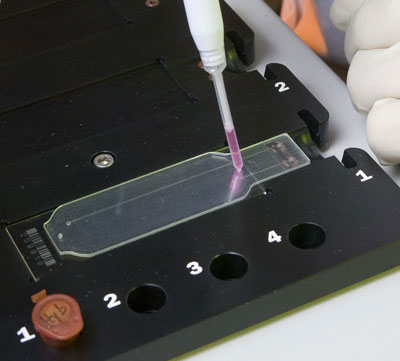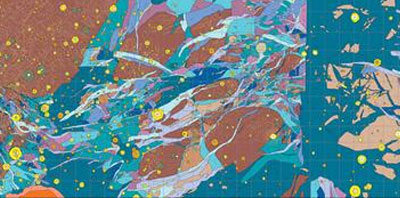 Welcome to another (late) edition of your favorite science column! This week, watch the last ever launch of Space Shuttle Atlantis, witness the largest science experiment ever, see an icy moon in a new light, and scan for viruses with medical tricorder 1.0. All this and more, plus our gadget of the week: a violin-playing robot!
Welcome to another (late) edition of your favorite science column! This week, watch the last ever launch of Space Shuttle Atlantis, witness the largest science experiment ever, see an icy moon in a new light, and scan for viruses with medical tricorder 1.0. All this and more, plus our gadget of the week: a violin-playing robot!
Final Launch of Space Shuttle Atlantis
Yesterday, Friday May 14th, was the last ever launch of Space Shuttle Atlantis on STS-132, a mission to take astronauts to the space station one last time before becoming a museum piece. The 32nd and final launch of Atlantis, which first launched in 1985, successfully took six astronauts to the ISS and delivered an integrated cargo carrier and a Russian-built mini research module. An important moment for NASA as it counts down to the end of the shuttle program entirely, Atlantis will be retired upon its return to Earth. The last ever shuttle launch will be of Space Shuttle Endeavor on September 16th.
Largest Science Experiment Ever Will Shoot Lasers Across 3 Million Miles
In the largest science experiment ever designed, a joint NASA-ESA mission plans to send three spacecraft to orbit around our sun 3 million miles apart and have them shoot lasers to each other. The project is all in an attempt to prove the existence of gravitational waves, the last piece of Einstein’s theory of relativity that is yet unproven. The Laser Interferometer Space Antenna (or LISA) plans to do just that. Einstein’s general relativity predicts several things, such as gravity’s ability to bend time light and the constant speed at which gravity travels. But a means to prove the existence of gravitational waves — huge ripples in time and space that flow outwards from the collision of huge celestial bodies like black holes — has eluded scientists for years.

LISA to unravel the final piece of Einstein’s theory of relativity
New Map of Ganymede Unveiled
In a combination of spacecraft surveys, an astronomy team has unveiled a brand new geologic map of Jupiter’s largest moon, the frozen world of Ganymede. The team from Johns Hopkins University’s Applied Physics Laboratory, who recently published the map in the Journal Icarus, combined data and images from past Voyager and Galileo missions to Jupiter. The moon is interesting to scientists because of its dichotomy in surface color and features. About a third of the frozen moon’s surface is covered in dark material while the rest is a mixture of brighter, newer features, says the study. “The dichotomy between these two basic terrain types leads to a number of fundamental questions about the formation and evolution of the surface of Ganymede,” the study authors note, “The current best guess from crater statistics is that light materials formed at some time during the middle half of Solar System history, but obtaining an exact age is likely to remain elusive for a long time.”
Medical Tricorder 1.0 Scans for 2,000 Viruses
When Dr. McCoy on Star Trek aims his medical tricorder at a patient, it tells him exactly what’s wrong within seconds. Of course, that’s in the 23rd century. In 2010, we have the Lawrence Livermore Microbial Detection Array (LLMDA), a $500 device that scans a sample on a glass slide and tells you which viruses and bacteria are present within 24 hours. Not bad, considering. The array has 388,000 tiny probes in a checkered pattern on a 3 x 1-inch glass slide. The probes can detect any one of 2,000 viruses and 800 bacteria. That’s super-useful for medical forensics and even biodefense, since current techniques identify only 50 or so pathogens at a time. The lab is already working on a next-generation array with 2.1 million probes, enough to detect 5,700 viruses and “thousands” of bacteria. Now if we could only get at-a-distance scanning and instant analysis, then we’d have Starfleet’s favorite medical tool. (via DVICE)

The new LLMDA is one step closer to a real tricorder
Gadget of the Week: Not Quite Positronic, But Toyota’s Robot Sure Can Play the Violin
Yet another car company is trying its hand at humanoid robots, and Toyota’s newest creation, which looks strikingly similar to Hondo’s Asimo, can get up on stage and play the violin. Toyota has been working on this little guy for about three years, and they have just finally shown it off in the Japanese Pavilion during the Shanghai World Expo. The little guy can play a tune or two, but he still doesn’t match up to our soul-filled longing-to-be-human Starfleet android, Data. Watch them both and see for yourselves!
#FollowFriday
If you are on Twitter, you know there are plenty of amazing people out there tweeting away. And, many of them are scientists! Every Friday I’ll be bringing you a new list of great scientists and techies to follow on Twitter. This week…
- @Calabrese666: Follow the horror rock band Calabrese who will be playing at this year’s Phoenix Comicon!
- @PhoenixComicon: The signature pop culture convention in the southwest, May 27-30 2010.
- @nieltyson: Niel deGrasse Tyson: Astrophysicist, American Museum of Natural History. Author: The Pluto Files, Death By Black Hole. Host: PBS NOVA scienceNOW
Science Quickies
Not enough science for you? Here’s a warp-speed look at some more science tid-bits that are worth a look.
- A rare meeting of planets and spaceships
- A soda fountain fit for the Enterprise
- Zombiesat attack! Solar storm fries satellite’s brain
TrekMovie’s Science Friday is an homage the the great NPR radio show Science Friday. Science Friday® is a registered service mark of ScienceFriday Inc.


The tricorder thing is really cool! It always makes me wonder what will happen next, and which trek tech will come into existence in our time. Trek inspires us all!
i am first well im not but if they prove you can blend time and space who will ever know who first again so i claim it now
The robo-violinist is cool and all, but I’ve never seen the point of humanoid robots, to be honest.
It strikes me that most useful robots out there are the ones that don’t look like anything but machinery, like the automated welding arms that put cars together.
It still beats that horrifying Japanese singing robot all to hell, though.
LISA is really intriguing. I hope it’s successful.
on a different note…
has anyone else noticed the mormon popup? i feel everyone has the right to chose what they believe. thats why i belong to the “church of trek”. i hope everyone sends emails to the mormons to help educate them in science and facts not fictional stories and polygamy.
Funny, some here claim the right to believe what they wish, fictional or not, but in the same sentance want to “educate” others that believe differently. Sounds like the same old tune to me.
I am so sad the Space Shuttle program is near an end.
#7
This thread is about SCIENCE, not your stance on religion. Keep it to yourself, pal.
Getting back to the topic at hand, the Japanese robot is really cool. Its too bad no one in North America has that same vision and creativity. Oh well.
And its too bad that NASA failed to design a new version of the space shuttle. Going back to the capsule mode is a step back in my opinion. I understand the need to cut costs, but it would be wise to design a new shuttle if we are to go Mars. And they should have started designing a new shuttle 15-20 years ago. If they had, NASA might be further ahead right now. And the Columbia accident may have been avoided.
Not knocking NASA, since they have clearly done a lot of great things, but the shuttle program should have been handled better in my opinion.
Sorry the first #7 was deleted.
Been waiting for a real tricorder for a long time. Number one thing I think would help the world. Doctors as of yet have done really nothing for me. Get me a tricorder and I’ll stop thinking of them as snake oil salesman and midieval barbers.
Wonder if the Toyota robot can play a violin version of “All Along the Watchtower…”
; )
Is there any way they can verify that was not a piped in performance? Not to be a skeptic, but some of his movements did not entirely seem in synch. Maybe the video just wasn’t fine enough to tell; I could be wrong.
Anyway, it’s a cool device, but I don’t see Carnegie Hall hosting an all-android orchestra anytime soon. : )
“gravity travels”… fascinating concept! Imagine that… it never occurred to me to think of gravity as the thing that’s moving ;)
The last two Shuttle missions are in flux right now, both because of delays or tight schedules with the cargo they’re supposed to carry. The next Shuttle mission, STS-133 Discovery is scheduled for September 16. The last Shuttle mission, STS-134 Endeavour is tentatively scheduled for November (no date set) but could slip to February, 2011.
STS-133 will carry the Leonardo cargo module which is being converted into a permanent storage module for the Space Station.
STS-134 will carry the Alpha Magnetic Spectrometer particle physics experiment.
We should know in the next few weeks if Congress and NASA choose to convert the STS-335 standby rescue mission hardware into a full-fledged mission, STS-135 to fly sometime early next year.
#12 Nice :)
@thorny…
thanks for the info on the next flights. gonna keep up with those so ill know the dates. i promised myself id b there for one of the launches ever since the program started. by the shat im goin to one of the last.
isnt it funny how we take things for granted til they are gone?
We need a good direction for NASA.
Is the robot actually playing or is it just aping not terribly close movements, while a recording plays the music? We’re not at anything impressive just yet.
Love the medical tricorder. Now THAT’s good science!!
Damn is my favorite science colum!
Amazing how far robot technology has advanced by now. I’m curious what’s next. I’d like a life-size version of my Femisapien ;-)
Concerning the gravity waves: “Einstein’s general relativity predicts several things, such as gravity’s ability to bend time light and the constant speed at which gravity travels.”
This is somewhat unclear. I guess what is meant here is that gravity can slow down time and bend the path of lightrays, and General Relativity also predicts that the effects of gravity disperse with the speed of light, they are not felt instantaneously by distant objects.
Absolutely pitiful that our space program is being tossed on the junkheap of history. Untold billions of dollars in economic development, incalculable science information, and now its all going to be a museum piece. We should be embarassed.
I am a “fiddle” player, not a true violinist.
BUT, I have seen a “Player Violin” machine, in Tucson, Arizona, one of a handful of mechanical devices from the 1800’s that exist.
THAT machine was truly marvelous to watch, as it replicated every single move a violinist can perform–including tremelo.
However, although this robot’s movements were fairly in synch “bow-wise”, I never once saw anything to indicate that the left hand was performing tremelo.
My conclusion: It may be a FAKE!
However, a very good mock-up.
Maybe someday we catch up to the 1800’s technology.
If anyone feels to dispute this, or comment, contact me at my email.
Mark Welborn